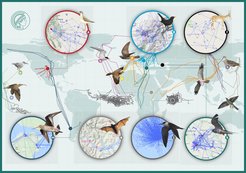Data from space unveils a global view of animals on the move
By scaling up space-based tracking, an “internet of animals” can help us measure and mitigate change on the planet
Scientists have begun tracking the global movement of individual animals with a new generation of miniature tags, opening a new frontier in efforts to monitor biodiversity change and pinpoint areas for conservation intervention. The project known as ICARUS uses a network of lightweight sensors attached to animals that transmit data to antennae in space, which in turn transmit the data to a single system for integration and interpretation. Since March 2021, the new technology has captured the movements of hundreds of animals from 15 species worldwide. Given the low cost and small size of tags, researchers hope to scale the effort to thousands of species and deliver data about animal lives globally in near real time. The study highlights how this “internet of animals”–when combined with other environmental and behavioral data—is poised to inform scientists about changes in the Earth’s ecosystems.

The new data and opportunities are described this week in the journal Trends in Ecology and Evolution. Movements across space and environments, home ranges, and migration corridors from these new data can be explored at the Digital Museum of Animal Lives (animallives.org), an initiative of the international Max Planck-Yale Center for Biodiversity Movement and Global Change (MPYC).
“This is the start of an era in which the movement of animals can monitor the health of our planet,” says Martin Wikelski, director at the Max Planck Institute for Animal Behavior in Germany, co-director of MPYC, and originator of ICARUS. “The first data from ICARUS is evidence that, with increased effort, a global network of animal sentinels is possible.”
The project ICARUS, or the International Cooperation for Animal Research Using Space, is a collaboration of international scientists led by the Max Planck Society. The effort relies upon volunteers to place sensors weighing less than five grams on animals. The sensors not only record GPS data but can also supply other information on conditions experienced by an animal, such as temperature. Data from the sensors are collected by antennae in space and then transmitted to computers on the ground. The project’s first antenna, which is aboard the International Space Station (ISS), will soon be joined by other receivers in orbit. The group are working to massively expand their space-based data collection devices, with plans including a microsatellite and a larger 2-satellite system, among other space assets.
The ICARUS tags that have been collecting data since March 2021 have yielded many insights about the 15 species tracked for the project. The tags’ tiny size (less than 5 grams) and solar power batteries mean that even small birds could be observed for long periods of time, revealing unknown aspects of their migration. For example, Hudsonian godwits fly nonstop from nonbreeding locations in Southern Chile to Mexico or across Central America to land in Texas, USA. And, common cuckoos conduct long water crossings over the Indian Ocean from India to Africa.
But the data provide more than missing details about the lives of individual animals—they offer a glimpse of how animal movement data, when collected at a vast scale, can create a living picture of environmental change on the planet.
“Rather than globe-orbiting sensors capturing images of the planet’s surface for subsequent interpretation, animals, through countless individual movement decisions, seek out their preferred conditions, sensing the quality and health of ecosystems in real time,” said Wikelski.
For instance, scientists will not only be able to identify areas essential for survival of the animals, but can also identify areas where biodiversity may be threatened by human encroachment or poaching when anticipated migration routes are blocked.
While most of the animals tagged so far are birds, researchers say that rapidly dropping tag sizes mean that someday many more reptiles, mammals, and even insects could be fitted with the sensors. With the technology now in place, the Max-Planck-Yale Center is currently raising funds to purchase more sensors, currently about $300 a piece, and to support researchers in different corners of the world to use and scale up the system, train volunteers, and integrate information-sharing platforms.
“The dream is an ongoing cohort of say 100,000 animal sentinels that help us humans measure, understand, and mitigate our changes to this planet,” said Walter Jetz, lead author of the study, co-director of the center and professor of Ecology and Evolutionary Biology and of the Environment at Yale University.












